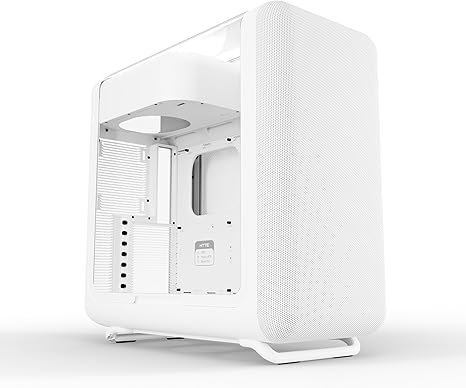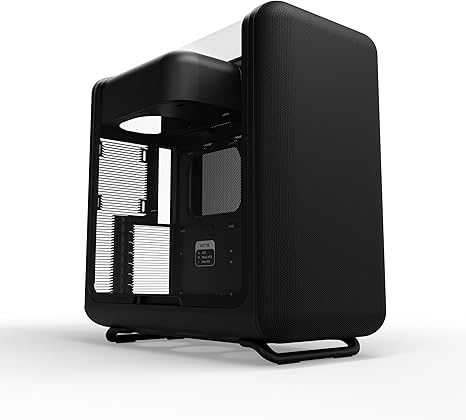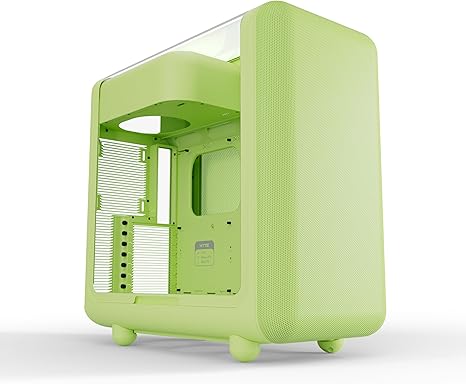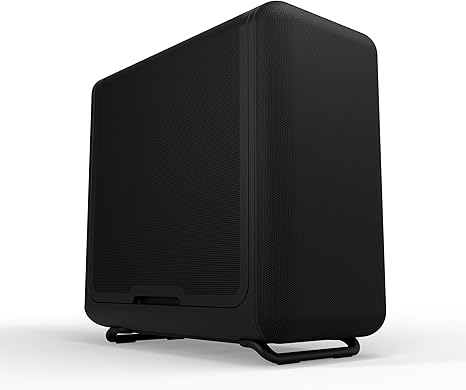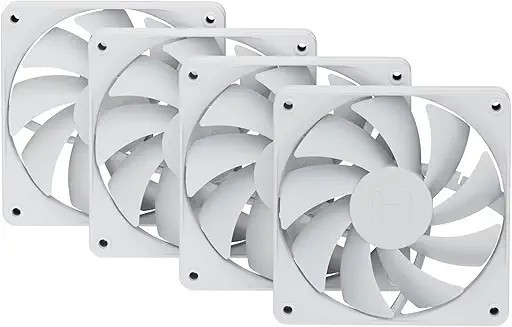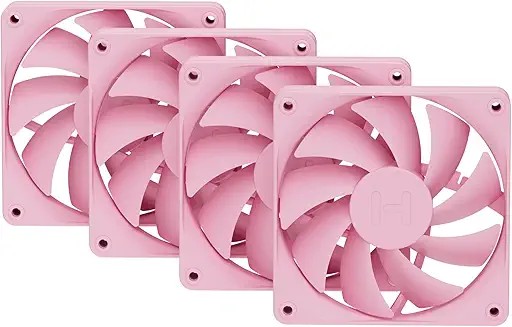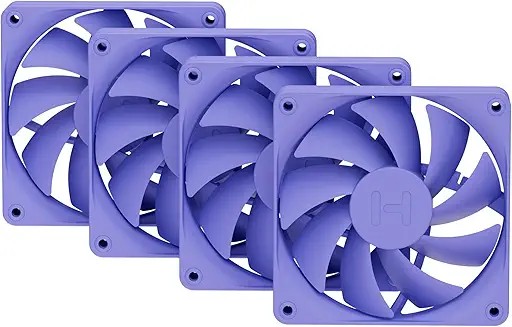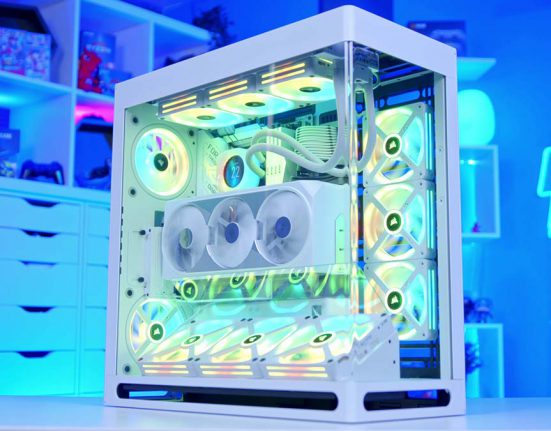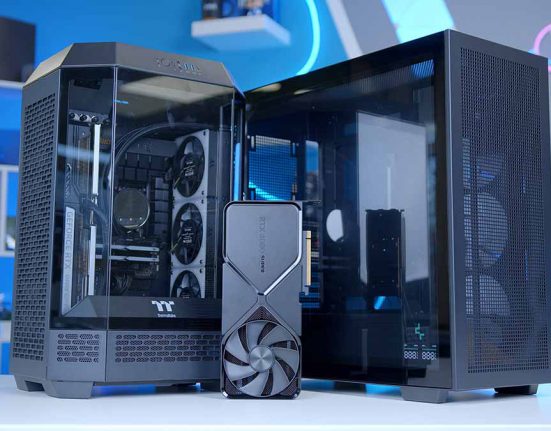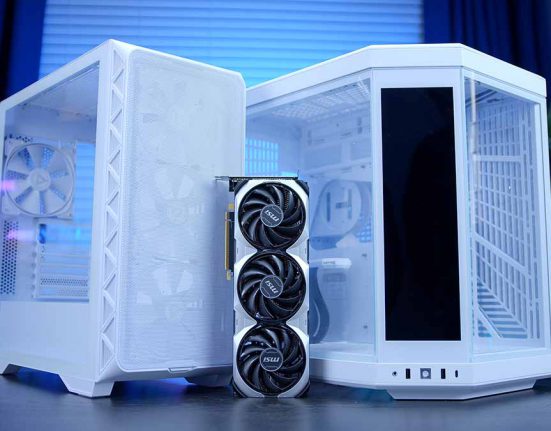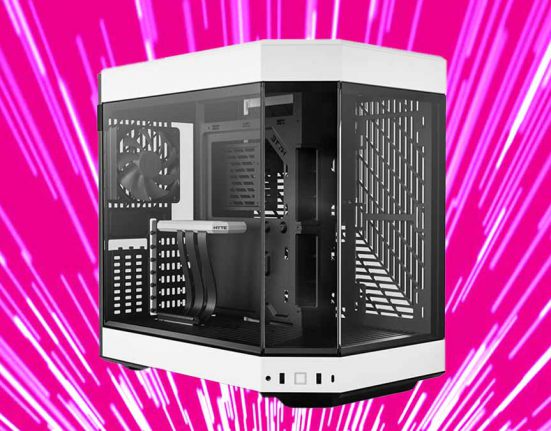Please note: This is an early review of the HYTE X50. We will update this article in the coming weeks with additional testing and build stills. Stay tuned as we will release a PC build featuring this case on our YouTube Channel shortly.
This is HYTE’s “impossible” X50 case, designed for you, a comfort-seeking, colour-loving PC den dweller. What’s more, this case isn’t just about aesthetic appeal; it’s about powerful airflow performance. HYTE believes your build should feel as good as it performs, and the X50’s sculptural curves and vibrant palette reflect a well-rounded and enjoyable approach to case design.
For this review, we’ve got our mitts on the Taro Milk colourway of HYTE’s X50, which is a soft, dreamy, and muted purple that nods to the pastel charm of taro bubble tea. Presumably named after the creamy drink made from taro root, this colourway is as comforting as it is unconventional. It’s the most adventurous shade we’ve reviewed at GeekaWhat, and it opens the door to fresh ideas and playful experimentation.
The HYTE X50 and HYTE X50 Air were initially teased at Computex in 2025, leaving many avid PC hardware enthusiasts and content creators bewildered by HYTE’s desire to adopt an entirely new design language for its cases. Over the years, HYTE has had success after success, first with its Y60 case, which transformed the chassis market and made fishtank-style cases all the rage. Then came the Y70 Touch Infinite, featuring a touchscreen that blends hardware controls with aesthetic customisations for showcase builds or streamers. It’s clear that HYTE are filled with creative ideas to get PC fanatics thinking.
Buy the HYTE X50 or HYTE X50 Air on:
Specification
With PC cases, it’s always tricky to estimate what their measurements mean in real-world terms, and often different shapes can feel deceivingly big or small compared to the more common, sharper geometric cases. The HYTE X50 measures 510 mm in length, 255 mm in width, and 515 mm in height, giving it roughly the same footprint as a mid-tower but with a more sculptural silhouette. That height puts it just above the likes of the NZXT H7 Flow or Corsair 4000D, while the depth gives it extra breathing room for airflow and cable management. It’s not oversized, but it will feel more substantial and pronounced thanks to its rounded edges and curved front bezel.

The X50’s internal layout is just as considered. It supports GPUs up to 430 mm in length, CPU coolers up to 170 mm tall, and ATX PSUs up to 223 mm long. Storage support is modest but sufficient, with room for up to two 2.5-inch drives and one 3.5-inch HDD. Cooling flexibility is a clear priority: the case supports up to three 140 mm fans at the front, three 120 mm fans on the side, three 120 mm fans on the bottom, and a single 120 mm fan at the rear. Its radiator support mirrors this, with space for up to a 360 mm radiator at the front or side, and a 120 mm unit at the rear.
There’s no top fan or radiator support due to the PSU canopy’s positioning. Still, the bottom and side mounts offer ample airflow potential, especially in the Air variant, where the mesh panel maximises intake and exhaust efficiency. Due to the lack of space for a top-mounted radiator, conventional mounting options are limited. Whilst mounting a radiator on the side or the front panels is fine, some coolers, such as Lian Li’s Hydroshift, feature hidden tubes and are designed for top mounting only, something to consider when purchasing a CPU cooler. Additionally, some coolers have fans preinstalled, but they are only in the correct orientation for exhaust and would need to be reoriented if mounted in this case. This is not a huge criticism of this case, however.
The X50’s front IO selection appears pretty standard at first sight; it has two USB Type-A ports and one USB Type-C port, a headphone jack and a power button. However, the USB Type-C port elevates it beyond most mid-tower offerings, with a premium 20Gbps of data transfer speed.
| Specification | HYTE X50 (& Air) |
|---|---|
| Form Factor | Mid-Tower |
| Motherboard Support | E-ATX | ATX | mATX | ITX |
| Case Dimensions (L x W x H) | 510 x 255 x 515 mm |
| Front IO | 2 x 3.2 Gen1 (5 Gbps) USB Type-A 1 x 3.2 Gen2 (20 Gbps) USB Type-C 1 x Combo Headphone Jack Power Button |
| PCI-E Slots | 7 x Horizontal |
| Colour Options | X50: Snow White | Pitch Black | Wild Cherry | Strawberry Milk | Taro Milk | Matcha Milk X50 AIR: Snow White | Pitch Black |
| Max Clearance | CPU Cooler Height: Up to 170mm GPU Length: 430mm PSU Length: Up to 223mm (ATX) |
| Drive Support | Up to 2 x 2.5 inch Up to 1 x 3.5 inch |
| Fan Support | Front: Up to 3 x 140mm Top: None. Bottom: Up to 3 x 120mm Side: Up to 3 x 120mm Rear: 1 x 120mm |
| Radiator Support | Front: Up to 360mm Top: None. Bottom: None. Side: Up to 360mm Rear: Up to 120mm |
| Pre-Installed Fans | None. |
| MSRP | X50: $159.99 X50 AIR: $129.99 |
Two case models will be available at launch: the HYTE X50 and the HYTE X50 Air.
HYTE X50 Variant
This variant embraces bold colour expression, launching in six shades: White, Black, Red, Green, Pink, and Purple. It’s designed for builders who want airflow and personality in equal amounts. The MSRP for this case is $159.99, reflecting the inclusion of a tempered glass panel that showcases your build.
HYTE X50 Air Variant
Focused on pure performance, the Air variant strips things back to the essentials, available in just White and Black. It’s the completely minimalist sibling, engineered for those who prioritise thermals above all, but who also like the X50’s rounded-edge frame. The MSRP for this case is $129.99 because the tempered glass panel has been replaced with a mesh panel, lowering production costs and boosting airflow.
Case Design
This bubbilicious case reflects today’s trends, embodying expressive, colour-coded minimalism with high-performance engineering and youth-driven design. Personally, I am living for the aesthetics, it’s giving Korean skincare fused with generalised kawaii culture – playful, colour-coded, and unapologetically expressive, all without compromising on thermal logic.
HYTE have stated that a lot of hard work, engineering, and time went into the design of this case. The X50 is branded as “impossible” due to the struggles the team faced in producing the full chassis in time for Computex – particularly the curved mesh steel panel, which proved a manufacturing headache.
The side panels are made of 1 mm-thick steel, and HYTE went through numerous iterations before landing on a successful design. Their goal was to create a frame that didn’t sacrifice structural integrity but still allowed ample airflow, all while bending and moulding steel to match the case’s intended sculptural silhouette.

The base X50 model features a vertical wraparound panel made from 4 mm-thick laminated acoustic-tempered glass. It includes a shatterproof (ish) bonding layer and is finished with colour-matched steel trim. The glass serves as a sound-dampening feature while offering a clean, open view into your PC’s internals – a blend of form and function that reinforces HYTE’s chosen design language without compromising on build quality. The panels of glass or steel will either slide or pop off as they are toolless.

Now, with any chassis that has a decent amount of tempered glass, airflow performance can become a bit of a concern. HYTE have tested their chassis against other competitors and found that the NZXT H7 Flow was the only case that had an inherent advantage in airflow performance out of all of the cases they tested. HYTE suggests this is due to the H7 Flow’s unobstructed mesh surfaces on all four sides of the case, compared to the X50.
Located on the near side of the top panel, as part of a thin bezel where the glass panel slots in, is the case’s front I/O. It features two USB Type-A ports, one USB Type-C port, a combo audio/mic jack, and a tactile mechanical power button. The cable routing for the front IO is hidden within an internal purple column to maintain an uninterrupted visual flow in your build.

Under the glass panel is the PSU shroud, relocated from the typical bottom-panel placement to work with gravity rather than against it for clean cable management. This can be achieved using the included white Velcro straps on the rear of the chassis.

Next to the straps, you’ll find HYTE’s patent-pending Louvred Blade Ventilation design, which reduces exhaust impedance without compromising your case’s robustness.
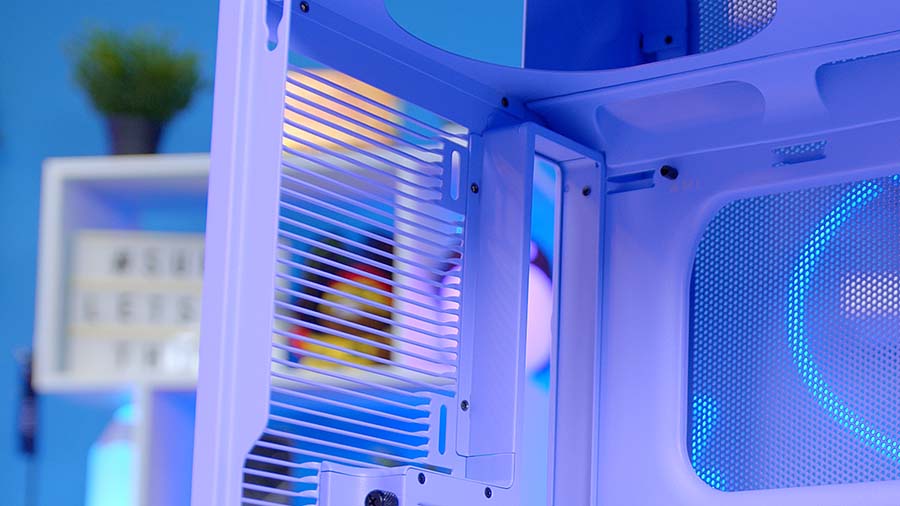
A standout feature we wouldn’t usually mention is the feet on this case. The X50 comes with either contemporary feet or paw feet, depending on the colour you’ve chosen. The colours Snow White, Pitch Black and Wild Cherry have contemporary feet, whereas the Taro Milk, Strawberry Milk, and Matcha Milk have paw feet.
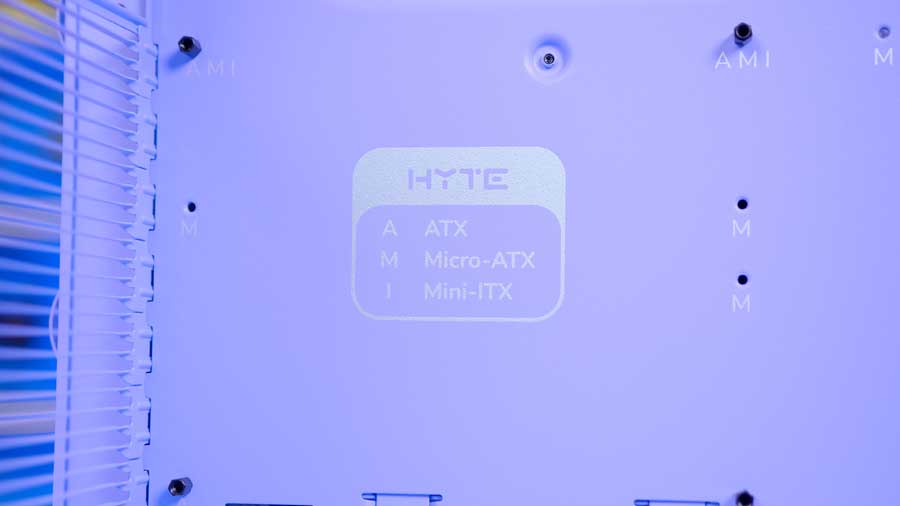
Moving on to the case’s internals, the motherboard tray greets us with a handy key indicator showing how the motherboard standoffs align for specific motherboard types, in a metallic, complementary silver print. This is an incredibly thoughtful quality-of-life feature for new builders, as it ensures that you can’t get it wrong!
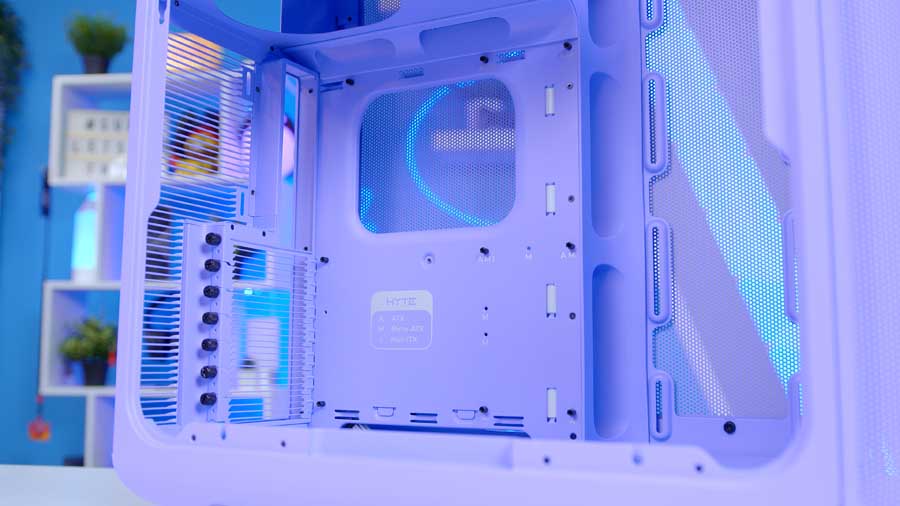
In the bottom panel, there is a fan mesh, as the bottom fans will serve as the primary intake fans in this case. Having that extra fine mesh keeps dust from being sucked right into your GPU.
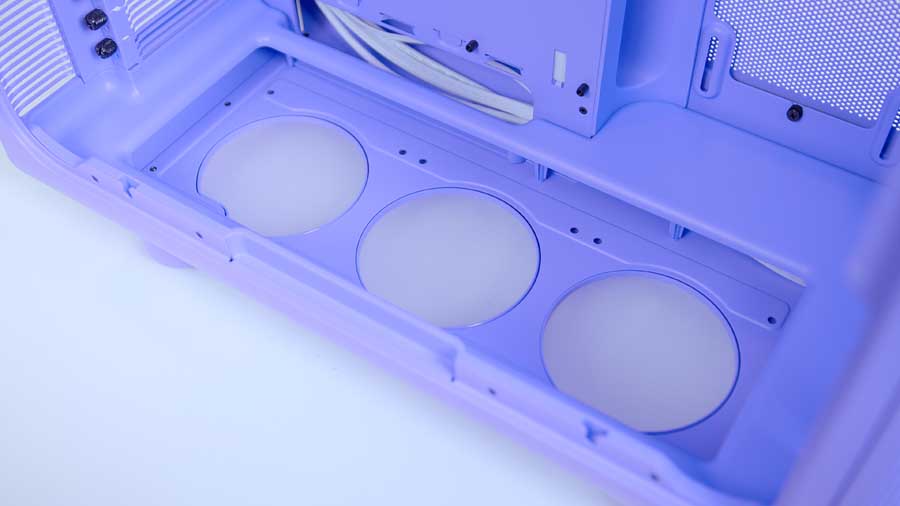
Behind the motherboard, you’ll find a fabulous cable management system implemented by HYTE. It features the white Vectro straps from before, colour-matched silicone grommets that give you total coverage and also purple tie downs.
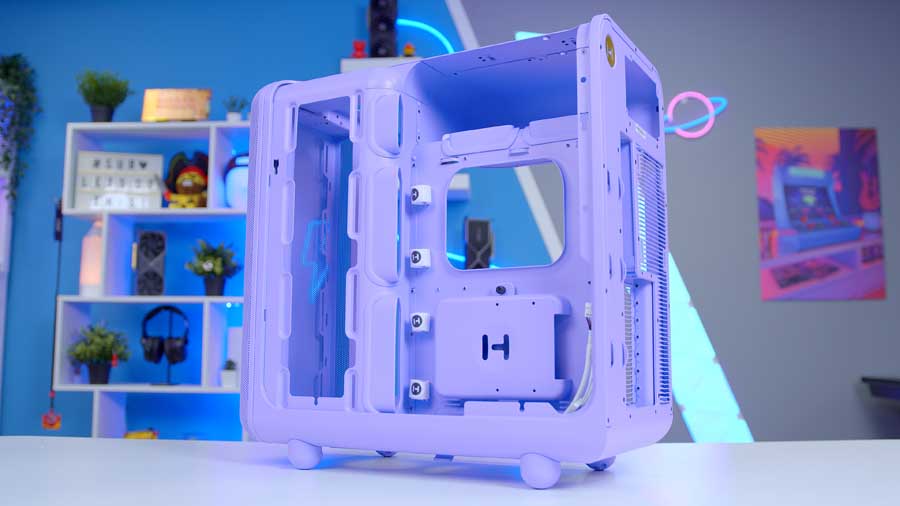
One fun fact about the launch of this case is that HYTE is including an exclusive limited-edition custom HYTE badge in polished gold for the first 50,000 units sold. This is a sweet touch as it’s almost like they are saying “thank you for purchasing”, I love when brands acknowledge their customer base!
Colour-Matched FA12 Case Fans
These have to be purchased separately if you are looking for fans that match your chosen colour, as neither of the X50’s variations comes with fans. These fans are colour-matched to the case colours and explicitly designed for colour-harmonised aesthetics in your pc build.
The only things letting these fans down are that they don’t have RGB, so they are a little bit lacklustre in the “cosy vibes” department, and that they’re eye-wateringly expensive compared to other hardware manufacturers’ fans. The Cherry, Taro, Strawberry and Matcha colours are also more expensive than the Black and White fans.
If the fans’ appearance and performance are the selling point for you, you can find them on HYTE’s website or check them out on Amazon and Overclockers above.
Features We Like
Overall Appearance
There’s something about this chassis; it strikes a delicate balance between futurism and retro, evoking a nostalgic sense reminiscent of PC cases from the early 2000s.
The Paw Feet

We like the paw feet for the Taro Milk, Strawberry Milk, and Matcha Milk colourways, but this is the only stand option they have for these. I think they should have made it so you could buy the Contemporary or Paw feet in either colour. Still, I understand that the decision has a deeper meaning, and it’s because HYTE wanted these colours to look cuter and appeal to people who would find this to be a visually pleasing feature, like myself.
Colour Matching

If you’re anything like me, you’ll find comfort in your PC setup matching and having a recurring theme. This is something we try to stick to here at GeekaWhat: we aim to compose PC builds that are all-white or have all RGB synced to a single colour. This creates a balance and reduces visual noise, elevating your comfort, helping you feel clean and organised, and relaxing your brain.
Suggested article: An All-White Gaming PC build using the APNX V2.
Features We Don’t Like
No Pre-installed Fans
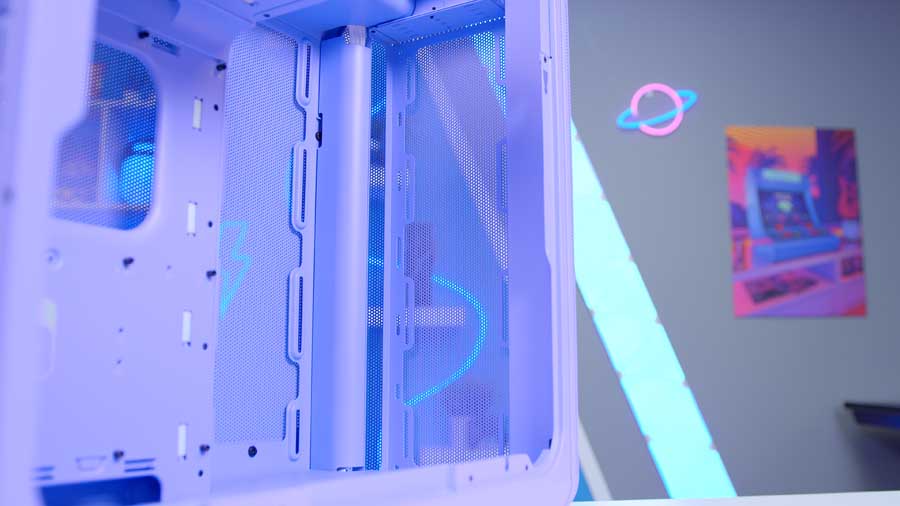
Personally, not having pre-installed fans in a case I want to purchase can make a real impact on my decision. I then have to weigh up whether I can expense extra fans on top of the case. I feel the MSRP is a little steep when you factor in the cost of the non-air case and coloured fans. I don’t think that this is an enthusiast-grade case, but we were starting to push enthusiast-grade prices for the sake of having some colour. I think the part that makes it just that extra bit sore is that the HYTE FA12 fans don’t offer RGB either; it’s difficult to justify the overall cost. But it is worth noting that the extra colours will cost more to manufacture than the regular black fans we see on the market.
External PSU Cable Trailing Down the Case
I appreciate that there are tie-downs, and you’re probably not going to see the wires or even the rear panel. HYTE, you could have had a little colour-matched spout/tube, just like the one inside that case, running down the exterior of the case to feed the PSU cable instead, or even some internal routing with a silicone grommet for the cable to come out? The panel slides off easily, so it wouldn’t be hard to access. Hyte already used colour-matched silicone, so was it really a complex accommodation to include this?
No GPU Support Bracket
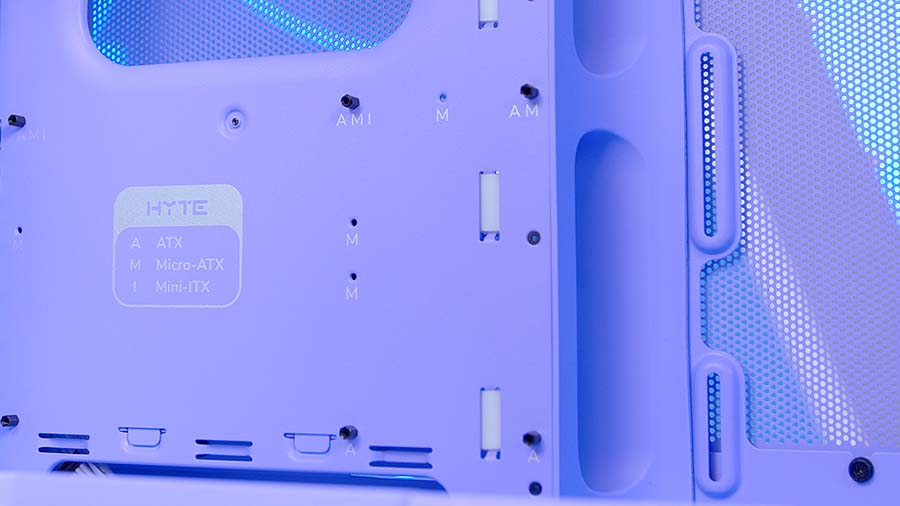
I don’t understand HYTE’s choice not to include an integrated GPU Support Bracket. The bottom panel isn’t high enough to add a free-standing GPU support bar either, so those heavy and expensive GPUs like the RTX 5090 might suffer and cause strain on the PCIe slot. It would have been nice for HYTE to integrate an arm to support graphics cards into their case, and they could have colour-matched it as well. This opportunity feels wasted when paired with white and purple cables; the internal design language might get thrown off.
Conclusion
HYTE X50 Case

Product Name: X50
Product Description: Modern Performance Case.
Brand: HYTE
-
Features
-
Design
-
Performance
-
Value For Money
Summary
In conclusion, the X50 is packed with thoughtful and considerate inclusions to make building in the case a breeze. HYTE’s effort and passion that have gone into engineering this case radiate from its design; their love for their customers and their hardware really shines through with the release of the X50.
The chassis is constructed from sturdy, high-quality materials that also double as a dust-resistant protective layer. However, it is a shame to see such steep price increases across the board, between models and fans’ colours, and the fact that there are no pre-installed fans solidifies my annoyance. I don’t really see how HYTE are justifying these prices together, especially considering the case can already set you back up to $159.99 at MSRP – talk about “pink-tax”.
The PSU shroud feels a bit obtuse, and the cable routing doesn’t quite make sense in practice. The PSU connector section juts out awkwardly at the top of the case, undermining the otherwise clean internal and external layout. It’s a frustrating oversight in a case that otherwise feels so considered.
The X50’s greatest strength is also its greatest weakness. By offering such beautiful, vivid colours, it creates a statement piece and almost leads consumers to commit to one colour for a setup. If, like me, you want all the colours but feel like it’s a big commitment, you’re left opting for the monochrome colourways, and you don’t get to tap into your creative side. (I’m now left hoping to steal it for my work PC instead.)
Finally, I think when all the components are mounted in the case, you’ll not be left with much internal space. This is just me being picky, but I’d want to display things in the case like cute little minifigures, and I’m not sure how it’ll fare – I will revisit this point when James builds inside the case.
Pros
✅ Vibrant and uncommon colours
✅ High-performance cooling
✅ High-quality
Cons
❌ Heavy
❌ Slightly expensive
❌ Obtuse features disguised as innovative



